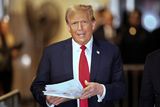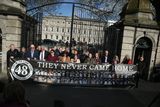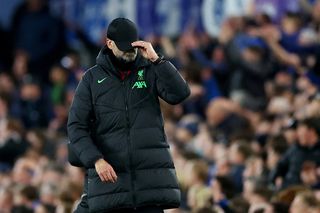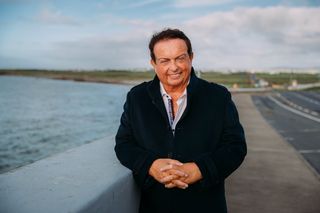Reviving and revering the memory of our Great Liberator
Daniel O'Connell, in the famed 1838 portrait by Sir David Wilkie
This coming Friday and Saturday, the O’Connell School will take place in Cahersiveen and Derrynane. Daniel O’Connell is fortunate in that there have been two major biographies in recent years by Professors Oliver MacDonough and Patrick Geoghegan.
Prior to that there was Sean O’Faolain’s magnificent ‘King of the Beggars’. There are numerous other works as well as Dan’s correspondence extending over many volumes and assembled by his kinsman, Maurice O’Connell. Nevertheless, the school will have a chance to preserve and revive the memory of the founding father of our democracy.
O’Connell was ahead of his time in many respects. He was, of course, the chief architect of Catholic emancipation: he was in favour of Jewish freedom too, and of freedom for the practice of all religions. He was a committed European – long before the disasters of two dreadful world wars. He was for the rights of women and against slavery.
O’Connell had many more accomplishments: he invented the prototype of the modern political party, followed by Parnell and afterwards by de Valera and Cosgrave. He founded the old National Bank. He was involved in many more business enterprises, though he did not have a good hold of money as far as he, himself, was concerned. He was a benign landowner and loved nothing more than to follow the drag hunts in his beloved Iveragh.
Talking of his fame, Gladstone said he regarded O’Connell as “the greatest popular leader the world had ever seen”. He praised him as a statesman who “never for a moment changed his end and never hesitated to change his means”.
In May 1798, he was called to the Bar at around the same time as Lord Edward FitzGerald was arrested by Major Sirr for his part in that year’s revolution. O’Faolain credits O’Connell with hardening his young idealism in one of the filthiest cockpits known to man – the Irish Bar before and after the union.
The persistence he displayed as an advocate proved to be even more beneficial for his political career. He was known as the Counsellor for much longer than he was called the Liberator. He believed passionately that the Irish were entitled to the same esteem as any other race. He railed against the English belief that they were a superior race. In the course of a speech in Westminster, he excoriated the Chief Secretary for Ireland, saying he was only an apprentice in politics. The prime minister, Wellington, had been Chief Secretary, as had Robert Peel.
“I have heard,” he said “that barbers train their apprentices by making them shave beggars. My wretched country is the scene of the political education of our statesmen, and the noble Lord is the shave-beggar of the day of Ireland.”
O’Connell spent 30 years at the Bar. After 1829 (with the arrival of full Catholic emancipation), he devoted himself more or less exclusively to politics. There was a ballad circulated after his death that marries the legal and political avenues open to him to achieve his political goal, the chief of which now was to repeal the Act of Union:
For 39 years I have witnessed his labours,
Unceasingly struggling his country to free,
At the Bar and the Senate I have watched his endeavours,
Releasing the chains of all tyranny.
But O’Connell was not yet finished with the law. In 1843, at the height of the monster meetings, he was charged with seditious conspiracy to bring about the repeal of the Act of Union. With five others he was charged with conspiracy to raise discontent and disaffection and to excite ill-will.
After a three-week trial, all were found guilty by a jury; O’Connell was sentenced to a year in prison. The verdict was appealed to the highest court in the United Kingdom, the House of Lords ,which found that the charges laid against O’Connell and the others were not good in law, that conspiracy was too loose a term and that there was not sufficient information in the charges to enable the defendants adequately to prepare their defence.
It remains a leading case on the law of conspiracy to this day, many astute lawyers being of the view that a charge of conspiracy should be availed of only in very rare circumstances.
O’Connell believed that change should be brought about by peaceful means. Later, those in the revolutionary mode would condemn him for yielding (as they saw it) to the British.
This is a time when there are going to be many commemorations. Some promote the cause of John Redmond, for example, and others who sought Home Rule. They would like that they are commemorated in our national parliament. Parnell and Davitt are so honoured. So should O’Connell.
At present his portrait bedecks one of the committee rooms only. O’Connell had no sense of false modesty. I think he would not be happy that his portrait is relegated to a side room. It should, I think, be displayed in the main vestibule of Leinster House – the ancestral home of Lord Edward FitzGerald. The Americans have always honoured in even measure their revolutionary and constitutional heroes. We should do the same. The visitors to Derrynane will be able to relish the surroundings that O’Connell so loved.
Professor Roy Foster concludes: “From the house the eye takes in the natural Atlantic harbour on which the family’s fortunes were based, the great sweeps of mountainy land which sustained them, the far-flung settlements of cabins and cottages which depended on estate and family.
“The atmosphere is at once Gaelic, seigniorial and Victorian: the place, like its master, is unique.”
Join the Irish Independent WhatsApp channel
Stay up to date with all the latest news















